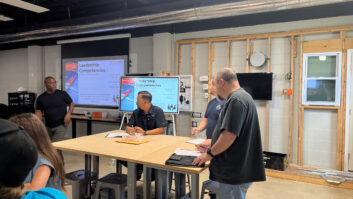I have always tried to be diligent about taking pictures of finished jobs, especially “before and after” shots to be used in our marketing materials. I think most of business owners in the industry do something similar. It always helps clients understand what the finished product will look like, be it a TV or touchpanel on a wall, in-ceiling speakers, or an AV rack in the closet. Similarly, all of our proposals include pictures of the products that we will be installing, so clients know what they are getting.

This photo shows how “ugly” it would look if we weren’t allowed to channel the walls to properly hide AV wires.
Twice, recently, we ran into a situation where clients didn’t understand what would happen during a pre-wire, no matter how much we explained in words. The biggest surprise seems to be channeling in solid block walls (we do a lot of work in NYC, with older, pre-war buildings where the walls are made of solid block, clay, or some other non-hollow material). This year we have had two clients walk onto the site during pre-wire or receive pictures from their designer or architect and been horrified by the channels that we had made in their walls. It seems that no matter how many times I told them that there would be long, six-foot wide gashes in their walls, it just didn’t register. We have had to stop work both times until we could arrange an on-site meeting with myself, the contractor and the architect and/or designer to calm the client down and get their buy-in that this is the only option if they wanted to have cable TV, music, and internet throughout the apartment.
So today I went to the jobsite and took pictures of channels with wire in them and channels with conduit in them. I also took pictures of holes cut in sheetrock for pulling wire through a ceiling, soffit, or wall. That way I can pull out my phone and show them exactly what I mean when I describe the work we will be doing. I have created an Evernote notebook titled “pre-wire pictures” that I can always access, no matter where I am and show it to a client during the preparation phase, so there are no surprises. I am very hopeful that this will reduce client stress and the stress they then put on us.

I have created an Evernote notebook titled “pre-wire pictures” that I can show a client during the preparation phase, so there are no surprises. This one shows pictures of a channel we cut through a plaster wall for our wiring conduit.
Now I’m making a list of all of the pictures I need to have and I will likely create a binder to bring with me, an Evernote notebook or a folder in Dropbox (or some combination of the three). Here are some ideas I have had already.
• Small holes where we “jump studs” when running around aluminum studs
• Before and after pictures of the channeling and drywall holes, so they can how seamless it looks once it is patched up
• Wire running holes in sheetrock and lath and plaster walls
• Wire management on the back of a TV on an articulating mount
• A speaker bar mounted abutting the TV and mounted with a gap
• Bookshelf vs in-wall/in-ceiling speakers
• Wire stapled to a baseboard (for that client that refuses to have the walls violated)
• A close up of an IR emitter on a TV
• Wire exiting a bulk faceplate
• Wire that will be seen if looked at closely behind outdoor speakers
Anything you can think to add? Share in the comments section below to help out your fellow integrators!
+Todd Anthony Puma is president of The Source Home Theater Installation in New York City.








